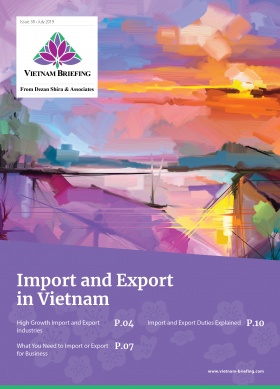An Introduction to Vietnam’s Import and Export Industries
- As Vietnam transforms into a global manufacturing hub, it has emerged as an effective relocation destination also known as the China+1 strategy.
- Upbeat growth projections are set for the country’s import-export business as the global economy resumes.
- Vietnam Briefing highlights gives an overview of the industries primed for import and export activities.
With its rising costs, China is no longer the go-to destination for many businesses, and Vietnam has arisen as a serious competitor. Recent trends show that the number of orders shifting from China to Vietnam has seen a significant increase.
For example, China’s Pearl River Delta, long known as one of the key factory centers for the world’s manufacturers (particularly those from Hong Kong) has now become too costly for many companies to stay in the region.
In the past few years, a growing number of businesses have relocated their operations from China to Vietnam in an attempt to escape rising costs and an increasingly complex regulatory environment.
Given the recent trade war between China and the US, alongside Vietnam’s recent free trade agreements such as the RCEP, the EVFTA, and the UKVFTA the country is steadily becoming more open to international trade and investment.
Located in a strategic position for foreign companies with operations throughout Southeast Asia, Vietnam is an ideal export hub to reach other ASEAN markets.
Compared with other developing markets in the region, Vietnam is emerging as the clear leader in low-cost manufacturing and sourcing, with the country’s manufacturing sector accounting for 25 percent of the country’s total GDP in 2021.
Webinar – Unveiling Southeast Asia’s Opportunities: 2023 Achievements and 2024 Prospects
[February 29, 2024 | 9:00 AM Los Angeles / 12:00 PM New York / 6:00 PM Brussels]
Join us in this data-driven webinar as Kyle Freeman, Partner and Head of the North American Client Services Desk in Asia, shares insights on Southeast Asia’s 2023 economic indicators and provides an overview of what to expect in 2024. The focus will be on trade and investment trends, noteworthy developments affecting businesses, and opportunities for foreign companies.
Currently, labor costs in Vietnam are approximately 50 percent of those in China at US$2.99 per hour compared to US$6.50 per hour respectively, and around 40 percent of those reported in Thailand and the Philippines. With the country’s workforce growing annually, Vietnamese workers are comparatively inexpensive, young, and, increasingly, highly skilled.
Another driving force behind Vietnam’s growing popularity is the country’s collection of free trade agreements.
The RCEP, which came into force on January 1, 2022, has also fostered the entry of goods exported in and out of Vietnam as it reduces cost, improves market access as well as offers streamlined customs procedures.
In terms of regulatory and financial incentives, Vietnam has become increasingly investor-friendly in recent years –the government has taken such actions as reforming its financial sector, streamlining business regulations, and improving the quality of its workforce.
Since the mid-2000s, the Vietnamese government has offered extremely competitive financial incentives to businesses seeking to set up operations in the country, in addition to a zero percent withholding tax on dividends remitted overseas and a low corporate income tax (CIT) rate of 20 percent. These advantages have enabled Vietnam to become a premier “sourcing economy” in the eyes of many companies.
See also: Vietnam Import Export Tracker
Current state of Vietnam’s economy
Vietnam is seeing strong growth on multiple fronts. Of particular interest to investors has been the continuing growth of Vietnam’s domestic consumer market, which has been developing by leaps and bounds.
This growth is expected to continue for some time to come – domestic consumption is predicted to increase at a rate of 20 percent per year. With a population of over 97 million and Southeast Asia’s fastest-growing middle class, Vietnam clearly represents an important market for foreign goods. Compared to 2017, the US has overtaken China for being the largest export market for Vietnam.
| Export Markets | Export Value (2021) |
|---|---|
| US | US$96.3 billion |
| China | US$56 billion |
| South Korea | US$22 billion |
| Japan | US$20.1 billion |
| Hong Kong | US$12 billion |
| Import Markets | Import Value (2021) |
|---|---|
| China | US$109.9 billion |
| South Korea | US$56.2 billion |
| Japan | US$22.7 billion |
| Taiwan | US$20.8 billion |
| US | US$15.3 billion |
Source: General Statistics Office
Industry Snapshots
While Vietnam is widely known for being a prime location for investors operating in the textile industry, there are many other business areas that are seeing significant growth in the country. Interestingly, Vietnam is well on its way to becoming a key location for high-technology manufacturing, with companies like Samsung, LG Electronics, Nokia, and Intel making multi-billion dollar investments into the country. Other business areas include information and communications technology, automotive, and medical devices.
Bilateral trade between Vietnam and the US hit a new record high in 2021, with a total of US$111.56 billion, up nearly US$21 billion year-on-year as per the General Department of Customs.
The US also had the second-highest import-export turnover with Vietnam at US$100 billion, followed by China.
| Top Exports | Export Value (2021) |
|---|---|
| Phones | US$57.5 billion |
| Electronic goods/Computers | US$50.8 billion |
| Machinery | US$38.3 billion |
| Textiles | US$32.8 billion |
| Footwear | US$17.8 billion |
| Top Imports | Import Value (2021) |
|---|---|
| Electronic goods/Computers | US$75.4 billion |
| Machinery | US$46.3 billion |
| Phones | US$21.4 billion |
| Fabrics | US$14.3 billion |
| Plastics (in primary form) | US$11.7 billion |
Textiles and Garments
Textiles consistently rank among Vietnam’s leading export industries, with over 6000 textiles and garments manufacturing companies, employing upwards of 2.5 million workers. The growth of the garment industry has been impressive and plays an important role in the economic growth of the country. In 2020, Vietnam surpassed Bangladesh to become the world’s second largest exporter of ready made garments (RMG). Further, the industry had an export market share of 7.05 percent in 2020, an increase from 5.54 percent of 2016.
China is the only nation that surpasses Vietnam in terms of net garment exports to the US. However, manufacturers and investors are pivoting towards Vietnam; the conditions for setting up shop are more economically convenient than doing so in China.
Within ASEAN, Vietnam is the strongest competitor for inheriting low value-added textiles and apparel manufacturing from China. In contrast to other leading textile exporters in the region (Indonesia, Thailand, Malaysia), the share of Vietnam’s textile exports against its total exports has grown in recent years.
Electronics
Vietnam has emerged as an important electronics exporter, with electrical and electronic products overtaking coffee, textiles, and rice to become the country’s top export item. Samsung is Vietnam’s largest exporter and has helped the country achieve a trade surplus for the first time in many years.
Exports of smartphones and computer parts now account for more in export earnings than oil and garments. Samsung has turned Vietnam into a global manufacturing base for its products, producing almost a third of the firm’s output. Samsung has invested over US$17.5 billion into the country as of 2021.
Samsung has also agreed to cooperate with the Vietnamese government in order to help develop the country’s domestic support industries. This represents a key business opportunity for foreign technology companies to set up operations in Vietnam and sell their components to companies like Samsung.
Pharmaceuticals
The future looks to be very interesting for the pharmaceutical industry in Vietnam. Vietnam’s pharmaceutical market is projected to increase to US$7.7 billion in 2021 and US$16.1 billion in 2026. Driving this market growth is the Vietnamese government’s goal of achieving universal health coverage, combined with a growing market of consumers who want accessible healthcare.
As per IQVIA (2021), as of 2020, the volume size for the industry was US$6.4 billion. Across the country, there are around 250 manufacturing factories, 200 import-export units, 4,300 wholesalers, and another 62,000 retailers catering to the pharmaceutical industry.
Automotive
Vietnam is becoming an important market for auto sales: the Vietnamese automobile market is expected to sell 1.7-1.85 million units by 2035. In the foreseeable future, an estimated 750,000-800,000 units are expected to be sold by 2025.
Although the nation’s rate of car ownership per capita is still much lower than other markets in Asia (only around 5.7 percent of Vietnamese households owned a car in 2020), Vietnam is still one of the countries with the fastest-growing purchasing power for personal cars over the past ten years. 9 percent of Vietnamese households are expected to own a car by 2025 – equivalent to the current level of India and the Philippines. By 2030, car ownership will reach 30 percent. Tax reductions on imported cars and increased income are attributed to the growth.
Despite an increasingly competitive auto market throughout the ASEAN region, Vietnam has stated that it intends to work aggressively to build up its own domestic auto industry. Among the key reasons for this goal is that the auto industry has the potential to create thousands of jobs for locals and create a strong system of supporting industries.
Additionally, Vietnamese automakers, such as VinFast have also started launching some first automobile models to the foreign market, signaling a promising future of cars exported from Vietnam.
Coffee
Vietnam is currently, the world’s second-largest coffee exporter, behind only Brazil. In 2021, the export value for Vietnam’s coffee reached US$3.1 billion. The industry plays an important role in Vietnam’s agriculture economy and is an export oriented industry with more than 90 percent of production volume exported. To increase its value, the government has been promoting the shift from exporting beans to processed coffee.
Many experts believe that Vietnam has the potential to overtake Brazil due to its favorable climate conditions and lower-cost production.
E-commerce
Vietnam is quickly becoming a prime market for foreign investment in e-commerce activities. The country’s rapidly growing economy and middle class are, in turn, spawning a strong consumer culture and increasing levels of disposable income. The pandemic has accentuated the demand for electronic retail as delivery, ride-sharing, and e-wallets gradually become a norm for the Vietnamese, especially among the youth.
Vietnam’s e-commerce business increased by 18 percent to US$11.8 billion in 2020, making it the only country in Southeast Asia to observe double-digit growth during the pandemic. This opens a booming outlook for the country’s e-commerce growth.
Being a signatory to 13 FTAs, Vietnam also provides favorable conditions for investors to start a business in e-commerce with reduced or zero customs tariffs on commodities imported or exported from other countries.
FAQ about Vietnam's Imports and Exports
What are Vietnam’s main industries?
Vietnam’s main industries are: textiles, food, furniture, plastics and paper as well as tourism and telecommunications. Agriculture represented 14.8 percent of GDP and employed 38 percent of the total workforce in 2021, according to the World Bank.
What are the major imports of Vietnam?
Vietnam’s major imports are computers, electrical products, and parts, making up18 percent of total imports. After that are machines, instruments, and accessories, making up 16 percent of imports.
What are Vietnam’s major exports?
Vietnam’s major exports are telephones, mobile phones and parts thereof, making up 21 percent of total exports. Textiles come second making up for12 percent of exports.
Does Vietnam rely on imports?
Vietnam relies heavily on imports of intermediate goods such as semi-processed products and capital goods from China and South Korea, This has resulted in large trade deficits with these countries — in particular with China.
Who is Vietnam’s biggest trade partner?
Vietnam’s biggest trade partner is the United States, covering US$77 billion in goods. Second is China covering US$48.8 billion.
About Us
Vietnam Briefing is produced by Dezan Shira & Associates. The firm assists foreign investors throughout Asia from offices across the world, including in Hanoi, Ho Chi Minh City, and Da Nang. Readers may write to vietnam@dezshira.com for more support on doing business in Vietnam.
We also maintain offices or have alliance partners assisting foreign investors in Indonesia, India, Singapore, The Philippines, Malaysia, Thailand, Italy, Germany, and the United States, in addition to practices in Bangladesh and Russia.
- Previous Article Vietnam Business Forum 2022: Ripristinare l’economia e sviluppare le catene di approvvigionamento
- Next Article Vietnam’s Pharmaceuticals Industry: A Comprehensive Guide for 2022








Hello,
Pls mail me your newsletters
Regards
Nithin
[…] RELATED: An Introduction to Vietnam’s Import & Export Industries […]
Dear Nithin,
Feel free to sign up to our newsletter here at: http://www.vietnam-briefing.com/about-us/subscription.html
Kind regards,
Charles
best of the best
I have business interest with Vietnam, how do I get started please? Mostly on textile s and communication s
Thanks Oliver. Please reach out to our experts at vietnam@dezshira.com or http://www.dezshira.com who can better understand your query.
Great Day!
This is Jacob, field operation’s Manager and Sales Director of JRA & PEARL Enterprises!
I hope you are all safe and doing fine despite the global pandemic issue we’re currently facing. We’ve been a resilient and professionally transparent importer and exporter in Customs Administration in Philippines’ Trade and Forwarding industry with much established company grounds and affordably quoted products and commodities. Globally competitive offers, on timely faster transactions, and genuine service providers in every import and export Matters.
We’d like to seek for a mutually beneficial business partnership with your successive and respective company and team’s campaign. We are a brokerage; with different partners in import and export industry. Globally dealing with the customs administrations and different country’s ports and airline industry mainly for trading and forwarding different products and commodities coming from different countries around the globe.
We’d love to hear more from your company’s business success and we are looking forward for a better business dealings and partnerships with you!
Safest Regards,
JACOB J. TUBALLA
JRA & PEARL ENTERPRISES
404 A Femii Bldg. A. Soriano Jr. Ave. Intramuros Manila 1002
TEL. # 8371 1332 / 09064468845 / 09260394409
can you please send me ANY link where i can find exporters from vietnam
Hi Rahul,
Please contact our experts at vietnam@dezshira.com or http://www.dezshira.com who can help answer your query.
Hi, I am from India.
I need the list of importers n exporter from Vietnam. Want to explore areas where we can do good business together.
Will you suggest me how could I found importers of Vietnam.